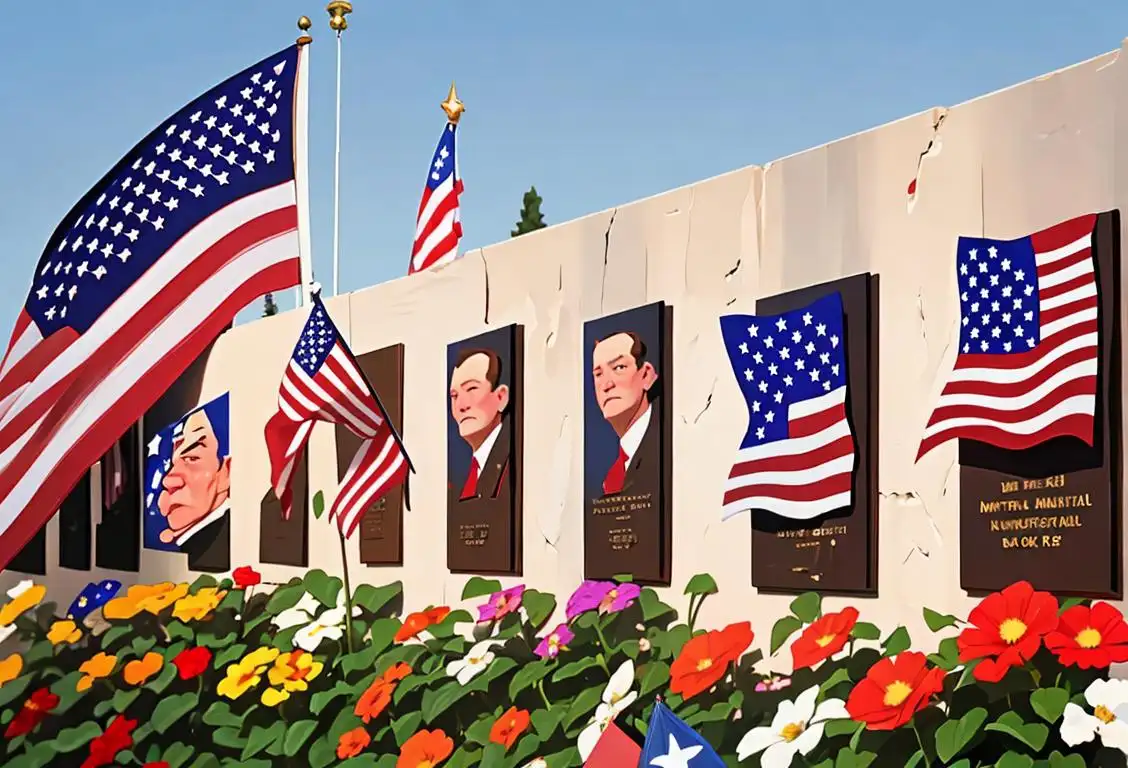National Library Outreach Bookmobile Day

Welcome to National Library Outreach Bookmobile Day! This delightful occasion celebrates the incredible impact of bookmobiles and the tireless efforts of library outreach programs. So grab your library card and let's dive into the fascinating history and significance of this special day.
When is Library Outreach Bookmobile Day?
It's national library outreach bookmobile day on the 7th April.
The Journey of Bookmobiles: From Literary Thunderstorms to Mobile Wonderlands
Imagine a world where books come to you, cruising through neighborhoods like magical literary caravans. Well, that's the enchanting reality of bookmobiles. These incredible vehicles take reading on the road, bringing the wonders of literature directly to communities far and wide.
Bookmobiles have a rich history that dates back to the early 20th century. The first recorded bookmobile service in the United States began in 1905, when a horse-drawn carriage filled with books started delivering reading treasures to rural communities in Washington County, Maryland. The program grew rapidly, and soon, bookmobiles were popping up in different states, sweeping readers off their feet and injecting newfound literacy excitement into their lives.
Over the years, bookmobiles evolved from simple horse-drawn wagons and trucks into full-blown mobile libraries on wheels. They braved all kinds of weather conditions and terrain, fueled by sheer love for spreading the joy of reading. These mighty vehicles traveled across mountains, plowed through snowstorms, and crossed treacherous rivers, bringing books to the people who needed them the most.
Today, bookmobiles continue to be beacons of literary delight, reaching underserved communities, schools, retirement homes, and rural regions. These modern marvels are equipped with cozy reading nooks, state-of-the-art technology, and expert librarians who offer personalized book recommendations and engage in delightful literary conversations with readers of all ages.
So why does National Library Outreach Bookmobile Day matter? Well, it's about celebrating the power of accessibility and the magic that happens when books find their way into every corner of society. It's a day to recognize the incredible efforts of librarians and volunteers who champion literacy and bring joy to countless lives through the wonders of bookmobiles.
History behind the term 'Library Outreach Bookmobile'
1839
Initiation of Public Libraries
Public libraries began to be established in the late 1800s as institutions intended to provide free access to knowledge and information. The development of public libraries allowed people of all backgrounds and economic statuses to have access to books and educational resources. However, many individuals, particularly those living in rural areas, faced challenges accessing these libraries due to their remote locations.
1905
Rural Libraries Begin
In 1905, the first rural libraries emerged in the United States, aiming to provide reading materials to people living in rural areas. These libraries were established to counter the lack of access to books and educational resources experienced by those who lived far from urban centers.
1857
Mobile libraries emerge
In 1857, a horse-drawn library wagon known as the Warrington Perambulating Library was introduced in Warrington, England. This marked the beginning of mobile library services, which aimed to bring books directly to areas without easy access to traditional libraries. These early mobile libraries were primarily used to serve rural communities.
1800s
The Rise of Libraries
During the 19th century, libraries saw a significant growth in popularity and accessibility. These institutions were primarily located in urban areas, leaving rural communities with limited access to books and educational resources.
1906
Bookmobile Idea Forms
Inspired by the success of rural libraries, Mary L. Titcomb, a librarian in Washington County, Maryland, suggested the idea of a book wagon to bring books closer to remote communities. This marked the initial conception of what would eventually become the bookmobile.
1912
Bookmobile Concept Born
The concept of a bookmobile, a library on wheels that could bring books directly to people, was first introduced in 1912 by Mary Lemist Titcomb, a librarian in Washington County, Maryland. She proposed using a horse-drawn wagon to extend library services beyond the confines of a physical building.
1905
The Book Wagon
In 1905, Mary Lemist Titcomb, a librarian from Maryland, came up with the idea of a mobile library to address the issue of limited access to public libraries. She created the concept of a 'book wagon,' which was essentially a horse-drawn carriage filled with books. This innovative solution allowed librarians to transport books to communities located far away from established library buildings.
1905
Mary Titcomb's book wagon
In 1905, the term 'book wagon' was first used in relation to library outreach. Mary Titcomb, a librarian in Maryland, introduced a horse-drawn book wagon to reach people living in remote areas. This innovative concept became popular and inspired other librarians to implement similar services.
1920
Motorized bookmobiles
With the advent of the automobile, bookmobiles transitioned from horse-drawn wagons to motorized vehicles. In 1920, the first motorized bookmobile, called the 'Travelling Library' was introduced in New Jersey, USA. These vehicles allowed library outreach programs to expand their reach as they could cover greater distances in a shorter time.
1920s
Motorized Bookmobiles
As the popularity of bookmobiles grew, the use of motorized vehicles replaced horse-drawn wagons. This allowed for greater mobility and efficiency in reaching remote communities. The first motorized bookmobile was introduced in Hagerstown, Maryland, in the 1920s.
1920
First Bookmobile Launched
By the 1920s, the first bookmobile, known as the 'Perambulating Library of the Appalachian Trail,' was introduced in Hagerstown, Maryland. This bookmobile, which consisted of a truck equipped with bookshelves, allowed librarians to transport books directly to people's neighborhoods.
1920
The Motorized Bookmobile
As the popularity and success of book wagons grew, librarians began to explore more efficient means of transportation. In the 1920s, the first motorized bookmobile was introduced, replacing the horse-drawn carriages. These vehicles were equipped with shelves, allowing for a larger selection of books to be carried. The motorized bookmobiles enabled librarians to reach even more remote areas, bringing the joy of reading and education directly to the people.
1939
Expansion and Integration
By the late 1930s, bookmobiles had become an integral part of library outreach efforts across the United States. The success of these mobile libraries led to an increase in their numbers and a more widespread adoption of the term 'bookmobile' to describe them. Bookmobiles became an essential tool for public libraries to extend their services to underserved communities, including rural areas, schools, and senior centers. The development of bookmobiles represented a commitment to democratic access to information and a dedication to serve communities beyond the physical library buildings.
1939
The Term 'Bookmobile' Coined
In 1939, the term 'bookmobile' was officially coined by the New Jersey State Library Association. This term gained popularity and became widely used to refer to the mobile library concept, emphasizing the primary purpose of the vehicles—to deliver books to communities.
1935
Library Outreach
The term 'library outreach' came into use in the 1930s as libraries began to actively seek ways to reach underserved populations. Bookmobiles played a pivotal role in these initiatives, bringing books, educational materials, and even librarians directly to communities that lacked easy access to libraries.
1950
Mass production and standardization
By the 1950s, bookmobiles started to be mass-produced and standardized. The American Library Association (ALA) worked on creating guidelines and recommendations for bookmobile design and maintenance. This standardization allowed libraries to acquire bookmobiles more easily and ensured a consistent level of quality across different programs.
1960s
Bookmobile Renaissance
During the 1960s, bookmobiles experienced a renaissance as libraries across the United States expanded their outreach efforts. The introduction of custom-built bookmobiles equipped with specialized shelving, audiovisual materials, and even air conditioning further enhanced their capabilities.
1950s
Expansion and Modernization
During the 1950s, bookmobiles experienced significant growth and modernization. Many libraries in different parts of the world started implementing bookmobile services as a means of extending their outreach and ensuring that books reached remote populations effectively.
1950s
The Introduction of Libraries on Wheels
In the 1950s, the term 'bookmobile' expanded to encompass a wider range of services. Libraries began to experiment with different types of mobile units, referred to as 'libraries on wheels,' to offer additional resources and services. These expanded bookmobiles included features such as audiovisual materials, computers, and interactive displays, providing a more comprehensive library experience in the communities they served.
1965
The term 'library outreach bookmobile'
In 1965, the term 'library outreach bookmobile' came into common use to describe these mobile library services. The phrase emphasized the dual purpose of the vehicles: bringing books to communities and engaging in outreach activities. Bookmobiles became important tools in promoting literacy, education, and community development.
1985
Term 'Library Outreach Bookmobile' Coined
The term 'library outreach bookmobile' emerged in 1985, highlighting the purpose of these mobile libraries as vehicles for outreach and community engagement. It signified a more intentional focus on connecting with underserved populations and fostering a love of reading regardless of geographical location.
Present
Modern bookmobiles and digital outreach
Today, bookmobiles have evolved to include customized vehicles equipped with Wi-Fi, computers, and e-books, adapting to the needs of the digital age. Library outreach programs also extend beyond physical bookmobiles, using online platforms and virtual services to reach wider audiences. The concept of mobile library services continues to thrive, ensuring access to education and literature for communities around the world.
1970s
Specialized Bookmobiles
In the 1970s, libraries began to introduce specialized bookmobiles to cater to specific populations. These included multicultural bookmobiles, which featured books in different languages to meet the needs of diverse communities, and children's bookmobiles, designed to engage young readers.
Present
Library Outreach Bookmobile Today
Today, the concept of the bookmobile has further evolved, incorporating new technologies and adapting to the changing needs of communities. Mobile libraries continue to play a crucial role in library outreach initiatives around the world. They serve as catalysts for literacy, bringing books, educational materials, and community programs to people who might not otherwise have access to them. The term 'library outreach bookmobile' represents the ongoing commitment of libraries to reach out and connect with diverse communities, ensuring that knowledge and reading opportunities are available to all.
Today
Library Outreach Bookmobile
The term 'library outreach bookmobile' refers to bookmobiles that are part of library outreach programs. These mobile libraries continue to serve as essential resources, particularly for underserved communities, by promoting literacy, education, and access to information.
Did you know?
Did you know that the world's largest bookmobile is the 'Biblioburro'? Created by Colombian teacher Luis Soriano, this extraordinary bookmobile is powered by two donkeys named 'Alfa' and 'Beto.' Together, they traverse the rugged terrains of Colombia, carrying books to remote villages that lack easy access to libraries. Talk about a literary road trip!Tagged
awareness funFirst identified
7th April 2021Most mentioned on
7th April 2021Total mentions
8Other days
Nurses Day
Former Prisoner Of War Recognition Day
Press Day
Handloom Day
Heroes Day
Memorial Day
Dance Day
Bestfriends Day
Liberation Day
Love Your Pet Day









